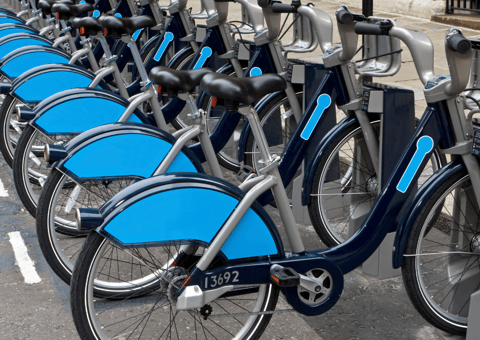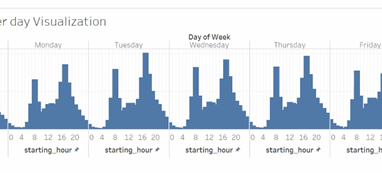eBike Sharing System
COMPANY OVERVIEW
The company has an ebike sharing system that serving a few cities in Canada. It adopts the concept of being able to use a bicycle just like a taxi.
Their stations can be found at major intersections in the city.
It has complete stations made up of pay stations, bikes and bike dock. All stations are both electrical and solar-powered.
CHALLENGE
The business is looking to improve its planning processes, and essentially strengthen their demand prediction capabilities.
results
Exploratory analysis of the data showed the following:
There are two distinct demand patterns on weekdays and weekends:
- On weekdays, demand is highest between the hours of 7am and 9am, and 4pm and 6pm
- On weekends, demand is highest between the hours of 2pm and 4pm


SOLUTION
Define the problem
Performe ETL - extract, transform and load the data
Explore and visualize the data - Identify demand pattern based on weekdays and weekend, and temperature
Identify relevant variables - variables that influence bike rental demand, such as weather conditions, holidays, etc.
Build a predictive model that can accurately forecast bike rental demand by hour of the day
Validate the model
Implement the solutions
Monitor and improve the solution


Exploratory analysis of the data showed the following:
There are two distinct demand patterns on weekdays and weekends:
- On weekdays, demand is highest between the hours of 7am and 9am, and 4pm and 6pm
- On weekends, demand is highest between the hours of 2pm and 4pm
RECOMMENDATION
Based on the analysis of the ebike demand patterns, here are some recommendations:
Increase bike availability during peak hours
To meet the high demand during peak hours, increase the number of bikes available during the hours when demand is highest. This will help to reduce wait times for customers and improve customer satisfaction.Offer promotions during off-peak hours
To encourage customers to rent bikes during off-peak hours, the bike company could offer promotions or discounts for rentals taken during these times. This will help to even out demand throughout the day and increase revenue for the company.Use data to inform business decisions
The analysis of bike rental demand patterns should be an ongoing process, with the bike company regularly monitoring and analyzing data to inform their business decisions. This will help the company to stay competitive and adapt to changes in customer demand over time.
CALL TO ACtion
Here are some next steps to consider:
Optimize bike fleet management
The bike company should analyze the data on bike rental demand and optimize their fleet management accordingly. This could involve adjusting the number of bikes available during different times of the day, as well as repositioning bikes based on the location of the highest demand.Improve bike maintenance
With high demand during peak hours, it's important to ensure that bikes are in good condition and available for customers to rent. The bike company should focus on providing regular maintenance for their bikes to ensure they are safe and functional for customers to use.Implement a dynamic pricing strategy
consider implementing a dynamic pricing strategy that adjusts prices based on demand. This will help to incentivize customers to rent bikes during off-peak hours and increase revenue during peak hours.
